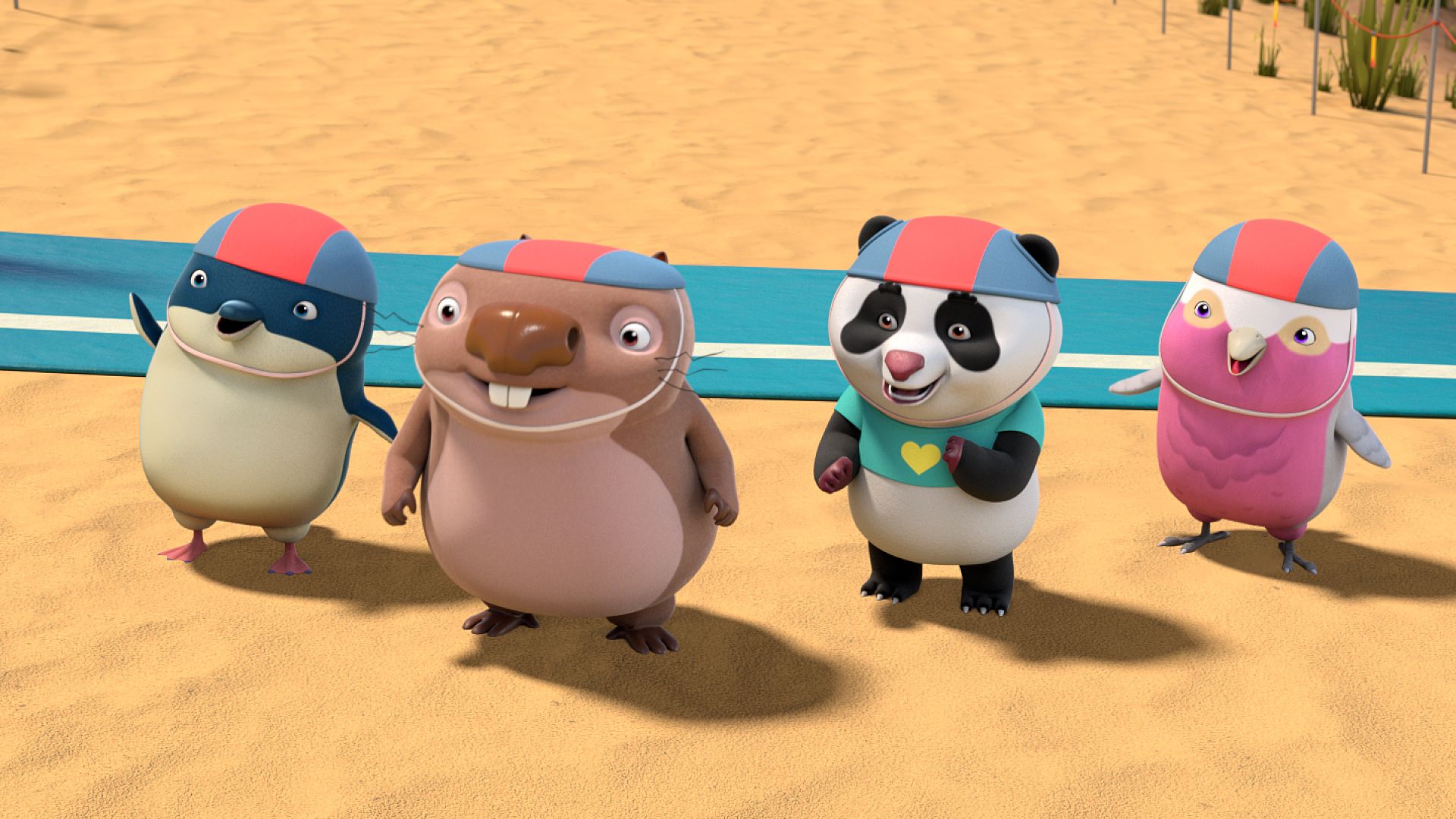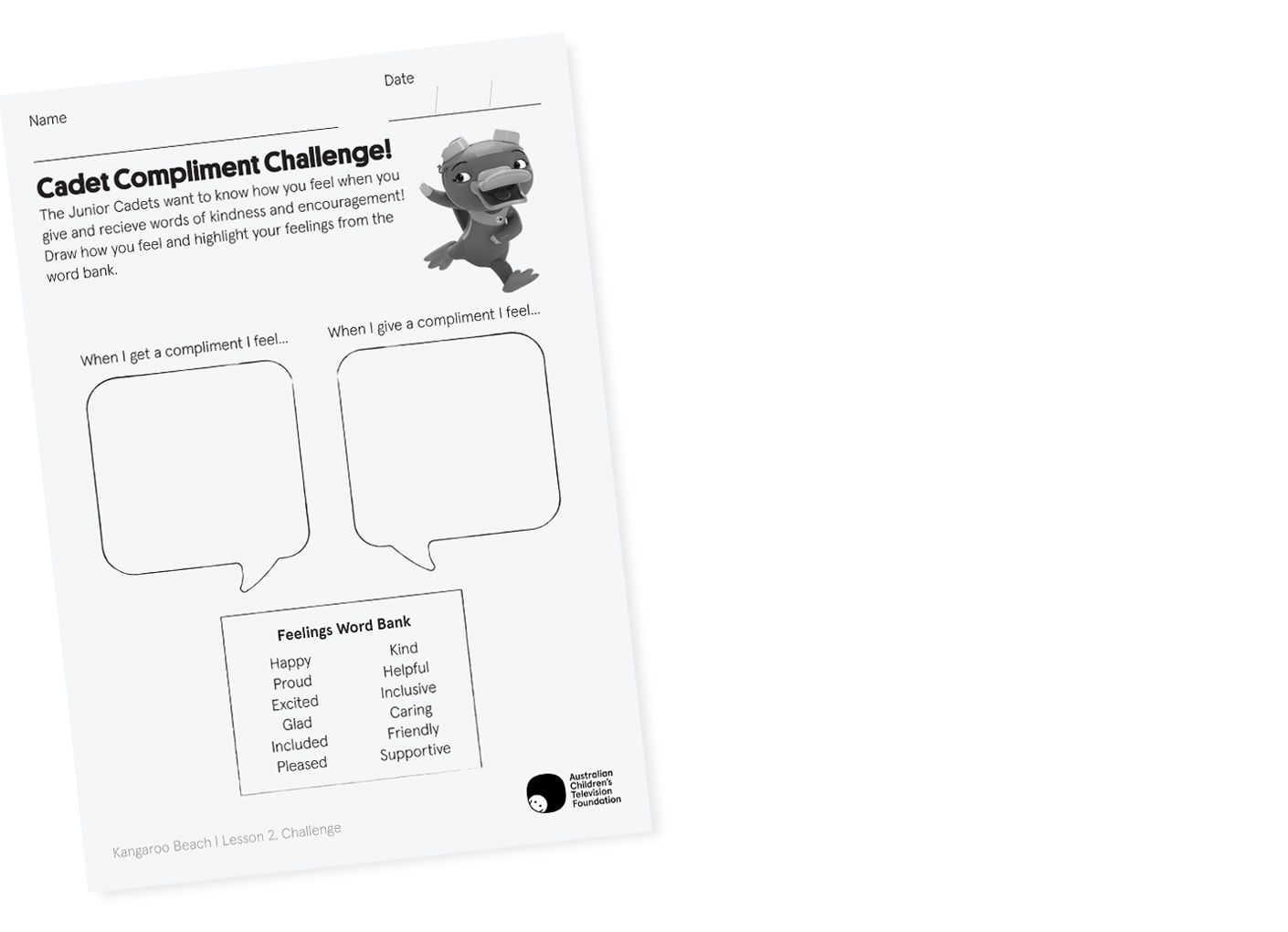
Lesson 2: Challenge

Learning intention: In this lesson, you will design your own movement games, learn to celebrate the efforts of your friends, and practice movement skills that help you to get better at floating.
Task 1: Design Your Own Triathlon
Watch
Watch Kangaroo Beach Series 3 Episode 7: 'Big Baby Cadet Challenge'
Reflect
- What activities do the Junior Cadets include in the course they set up for the little ones?
- How might activities like hopscotch, jumping, dodging balls and running on dry land help the Junior Junior Cadets – and you – improve your swimming? Talk to a friend then share your ideas with the class.
Did you get any of these answers?
- Jumping from two feet to two feet helps swimmers push off for fast starts and turns. It also builds your leg muscles and helps you kick more powerfully through the water.
- Sprinting teaches your body to move quickly and burst into action. This helps you swim faster. It also makes your tummy muscles strong so you don't wobble around in the water and waste energy.
- Dodging helps you learn where your body is, even when you're moving fast! This helps you know exactly where your arms and legs are in the water so you can keep your body straight and smooth when swimming.
Create
Use the Junior Cadet’s ideas to design your own triathlon. It might not be possible to include a swimming and a bike-riding section, but come up with three clearly different parts (some ideas are below). Do not make anything too hard – it is important to make sure everyone can join in, be active and have fun.
1. Plan a running path. This part is for sprinting flat out. It could be around the edge of a grassed area or a wiggly path through the playground.
2. Now make a jumping section. Get some ideas from the Junior Cadets’ challenge. Look for things in your school yard you can use, like cushions, rubber circles, squares and lines on the ground, or logs. You might get racers to zig-zag jump over a line, or draw a row of hopscotch marks in chalk for people to leap and hop their way through. Make sure your contestants jump from two feet to two feet, like a kangaroo, pushing off the ground every time, and swing their arms from behind them to in front every time.
3. Finish with a ‘dodging’ section. Mark off an arena and have racers dodge a series of high, medium and low items. The Junior Cadets used beach balls, you could use ballons, or soft foam balls rolled or gently tossed around. Other ideas might be a jump rope that is swung, tape stuck between two chairs at different heights, or contestants dodging pool noodles that are gently swung through the air.
Goal: Racers aim to complete the course, not to win. With practice, you can make your triathlon even more fun and challenging. Remember to be safe and have fun.
Task 2: Strong Tummy Float Skills
Watch
Reflect
Tell a partner about the important parts of floating. Then explain to another pair why floating is important thing to do while you wait for help to arrive. Together watch this Kangaroo Beach video on floating.
Explore
Here are some moves you can practise on land which make floating easier in the water. They make your tummy muscles strong, and this can help keep your body flat on the water and stop your legs from sinking.
Line up on one side of an open space, and do these different Beach Animal Moves back and forth across the space.
- Crab Walk: Sit with bent knees, hands flat behind you, fingers pointing forward. Lift your tummy off the floor and scuttle like a crab. Move forwards, backwards, and sideways across the space. Tip: put a beanbag on your tummy and try to crab walk without letting it fall off. This helps you keep your bottom up high.
- Penguin Waddle: Stand tall with heels touching. Place a small, soft object (like a ball, toy, or rolled socks) between your calves. Waddle forward, squeezing your legs to prevent the object from falling. Tip: it’s easier walking on your heels, like a penguin does.
- Seal Slide: Lie on your tummy, push your hands up until your arms are straight, and move across the floor while dragging your legs.
Create
Can you come up with your own moves based on characters from the show? Or turn these moves into a game? Example: Race your friends to see who is the fastest seal. Deliver objects to a partner penguin. In crab walk, use your feet to kick a ball and knock down some bowling pins (or anything you can find).
Task 3: Compliments
Explore
Compliment Relay: This episode of Kangaroo Beach talks about ways to have fun during a physical challenge without focusing on winning. After you have done the obstacle course, the floating challenges or something else physical, form a circle to create a compliment relay with your classmates.
The first person says something they liked about another person’s effort, and then throws a soft ball or beanbag to that student. The person who receives the object then says a compliment to another student, and throws them the object, and so on. Make sure everyone is included and receives a compliment (depending on how many people you have, this game can be better played in two smaller groups, with the other half watching).
Put these example compliment sentence starters on the board so everyone can read them:
- I liked the way you…
- I noticed that you…
- I was impressed by …
- You put a lot of effort into…
- You worked hard at…
- Your… stood out to me.
- It was good when you…
- Your... caught my attention because…
- Your... was a highlight for me because…
Reflect
In pairs, talk about how it felt to give and be given compliments. Did it help to boost your confidence?
Create
Draw pictures to complete the Compliment activity sheet.

Australian Curriculum Links
|
|
Foundation |
Year 1 |
Year 2 |
|
Movement and physical activity: Moving our bodies |
practise fundamental movement skills in minor game and play situations applying different locomotor skills to move from one point to another applying fundamental movement skills for purpose and enjoyment in natural environments experiment with different ways of moving their body safely and manipulating objects and space suggesting and testing … different ways to use equipment and objects, and making judgements about which are most effective manipulating equipment… in imaginative play |
practise fundamental movement skills and apply them in a variety of movement situations performing locomotor movements using different body parts to travel in different directions selecting and implementing different movement skills to be successful in a range of games investigate different ways of moving their body, and manipulating objects and space, and draw conclusions about their effectiveness inventing new games, based on rules and equipment from familiar games, and drawing conclusions about whether the rules and choice of equipment provide for an interesting, challenging and enjoyable game using different types of equipment to create an original game |
|
|
Personal, social and community health: Interacting with others |
practise personal and social skills to interact respectfully with others |
identify and explore skills and strategies to develop respectful relationships demonstrating appropriate language (including verbal, non-verbal, body language and gestures) when encouraging and including others in physical activities, when completing movement tasks or practising for performance |
|
|
Personal, social and community health: Identities and Change |
investigate who they are and the people in their world identifying ways they use their strengths in physical activities to help themselves and others to be successful |
describe their personal qualities and those of others, and explain how they contribute to developing identities participating in physical activities and describing how their own and others’ personal qualities contribute to successful outcomes |
|
Australian National Benchmarks for Swimming and Water Safety
|
|
Fundamental Stage |
Acquisition Stage |
|
Milestone |
Float and recover to a standing or secure position |
Float, scull or tread water |